Recycling E-Waste and the Sustainable Economy: A Bibliometric Exploration
Abstract
:1. Introduction
2. Literature Review
2.1. E-Waste Recycling: A Sustainable Imperative
2.2. E-Waste Recycling Behavior
2.3. Research Trends in E-Waste Recycling
3. Research Methods
3.1. Data Collection
3.2. Research Methodology
3.2.1. Co-Citation Analysis
3.2.2. Analysis of Co-Occurrence
3.2.3. Analysis of the Topic
4. Results and Discussion
4.1. Data Visualization
4.2. Author Citation Productivity
4.3. Journal Productivity
4.4. Research Theme
- Cluster 1 (in red)—Influence of organic pollutants
- Cluster 2 (in green)—E-waste management and recycling in developing nations
- Cluster 3 (in blue)—Research on recovery and recycling of used materials
5. Conclusions
5.1. Summary
- Question 1: Which countries and journals exhibit the most robust research activity in E-waste recycling?
- Question 2: Who are the most highly co-cited authors, the journals, and the references in the field of E-waste recycling?
- Question 3: How have E-waste recycling studies evolved from 1990 to 2022?
- Question 4: What are the prevailing research trends in the global E-waste recycling domain?
5.2. Contribution
5.3. Limitations and Future Research
Author Contributions
Funding
Institutional Review Board Statement
Informed Consent Statement
Data Availability Statement
Conflicts of Interest
Appendix A
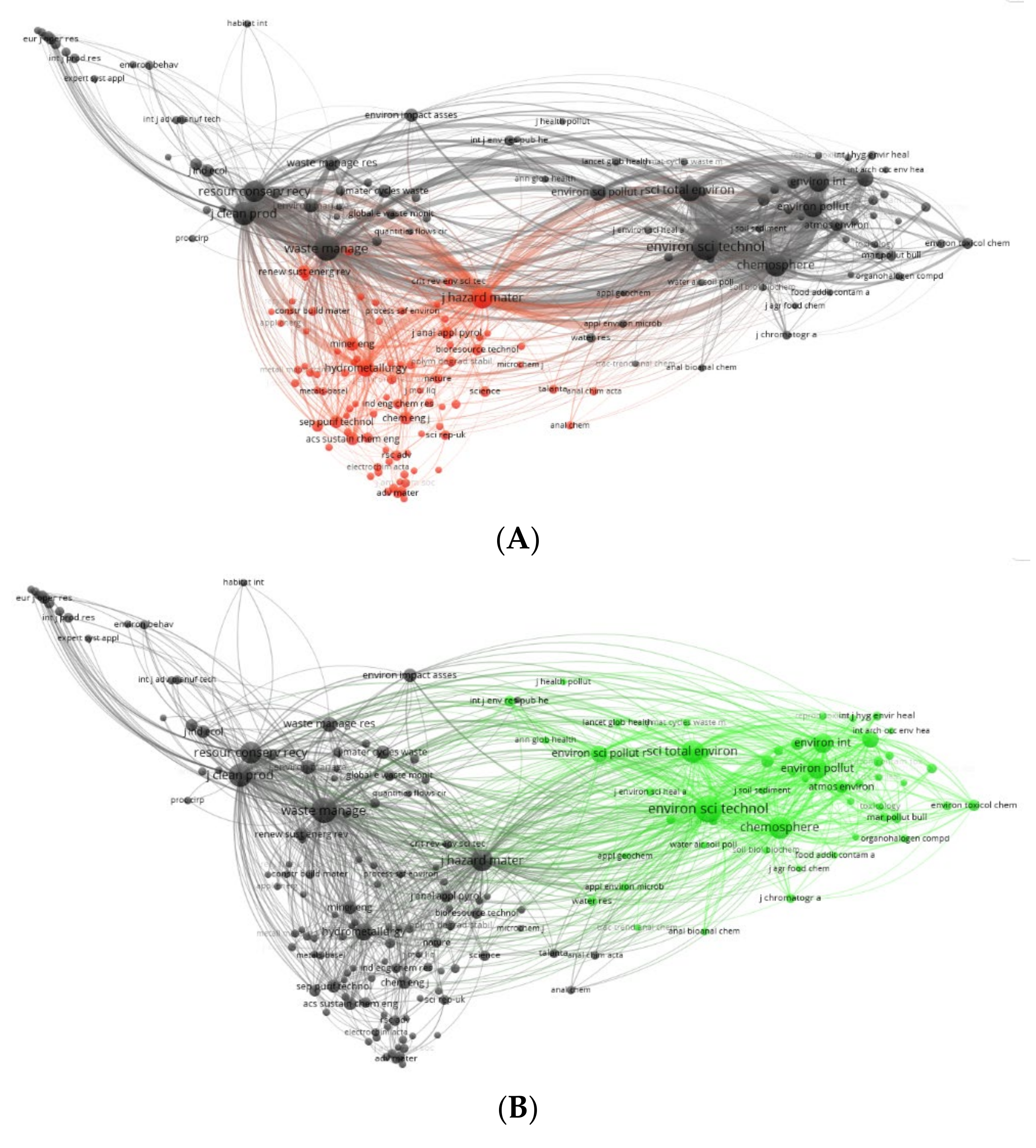
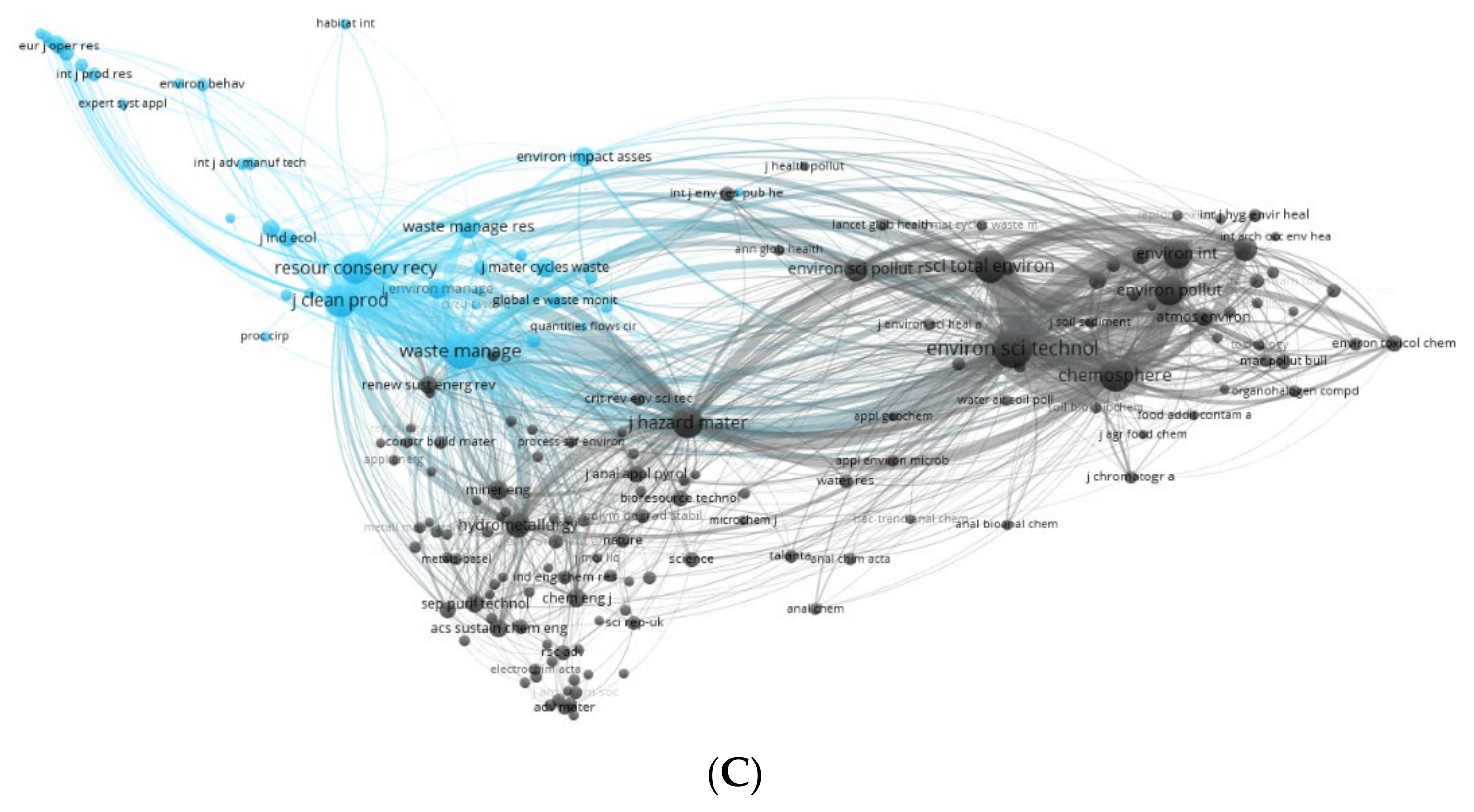

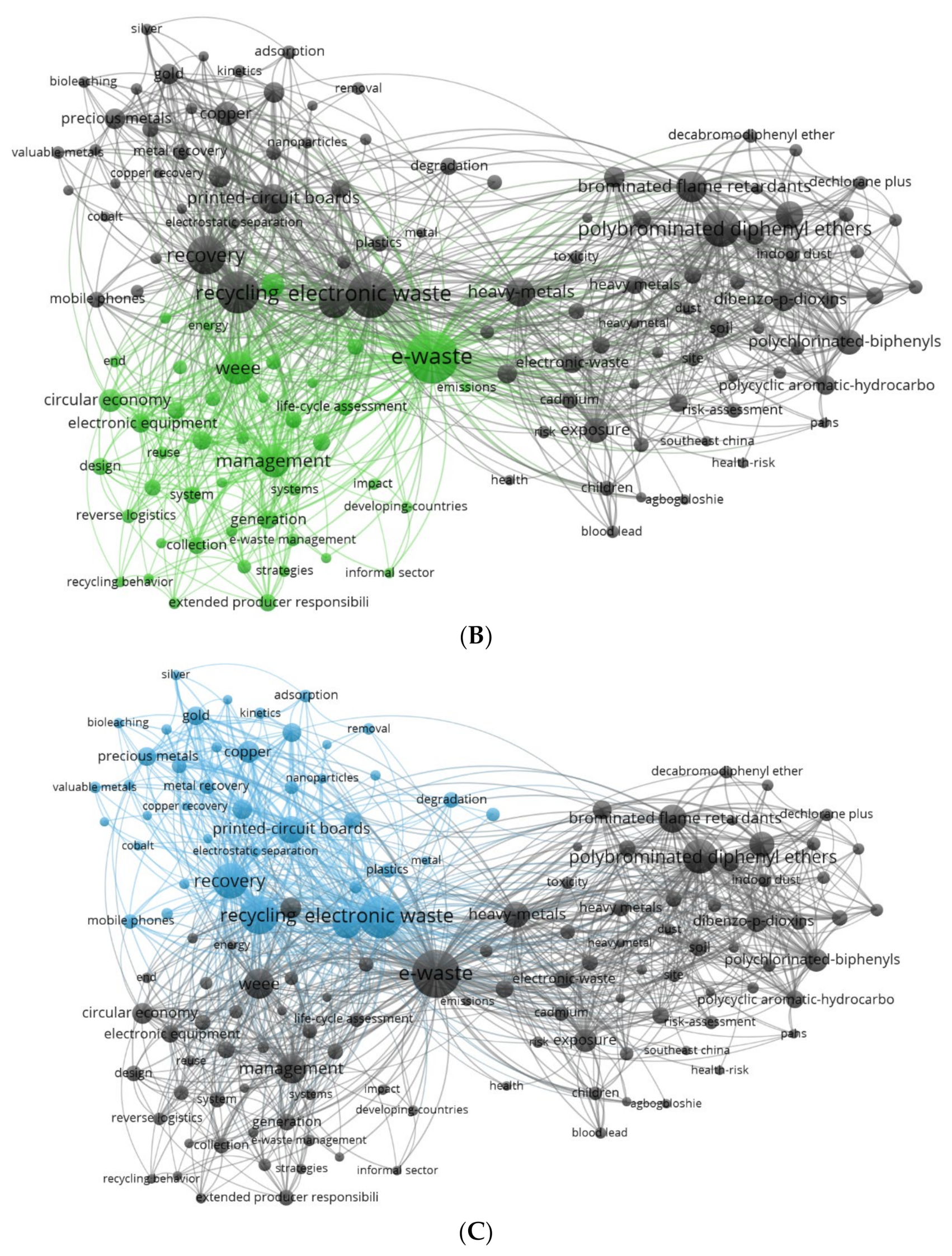
References
- Li, Z.; Li, X.; Qian, Y.; Guo, C.; Wang, Z.; Wei, Y. The sustaining effects of e-waste-related metal exposure on hypothalamus-pituitary-adrenal axis reactivity and oxidative stress. Sci. Total Environ. 2020, 739, 139964. [Google Scholar] [CrossRef]
- Andrae, A.S.G.; Andersen, O. Life cycle assessments of consumer electronics—Are they consistent? Int. J. Life Cycle Assess. 2010, 15, 827–836. [Google Scholar] [CrossRef]
- Baldé, C.P.; Forti, V.; Gray, V.; Kuehr, R.; Stegmann, P. The Global E-Waste Monitor 2017: Quantities, Flows and Resources; United Nations University: Bonn, Germany; International Telecommunication Union: Geneva, Switzerland; International Solid Waste Association: Vienna, Austria, 2017. [Google Scholar]
- Shagun, A.K.; Arora, A. Proposed solution of e-waste management. Int. J. Future Comput. Commun. 2013, 2, 490–493. [Google Scholar]
- Singh, S.; Trivedi, B.; Dasgupta, M.S.; Routroy, S. A bibliometric analysis of circular economy concept in E-waste research during the period 2008–2020. Mater. Today Proc. 2021, 46, 8519–8524. [Google Scholar] [CrossRef]
- Cordova-Pizarro, D.; Aguilar-Barajas, I.; Romero, D.; Rodriguez, C.A.J.S. Circular economy in the electronic products sector: Material flow analysis and economic impact of cellphone e-waste in Mexico. Sustainability 2019, 11, 1361. [Google Scholar] [CrossRef]
- Rochat, D.; Hagelüken, C.; Keller, M.; Widmer, R. Optimal recycling for printed wiring boards (PWBs) in India. In Proceedings of the R’07 World Congress, Recovery of Materials and Energy for Resource Efficiency 2007, Davos, Switzerland, 3–5 September 2007. [Google Scholar]
- Chauhan, G.; Jadhao, P.R.; Pant, K.K.; Nigam, K.D.P. Novel technologies and conventional processes for recovery of metals from waste electrical and electronic equipment: Challenges & opportunities—A review. J. Environ. Chem. Eng. 2018, 6, 1288–1304. [Google Scholar] [CrossRef]
- Finnveden, G.; Johansson, J.; Lind, P.; Moberg, Å. Life cycle assessment of energy from solid waste—Part 1: General methodology and results. J. Clean. Prod. 2005, 13, 213–229. [Google Scholar] [CrossRef]
- Forti, V.; Balde, C.P.; Kuehr, R.; Bel, G. The Global E-Waste Monitor 2020: Quantities, Flows and the Circular Economy Potential; United Nations University: Bonn, Germany; United Nations Institute for Training and Research, International Telecommunication Union: Geneva, Switzerland; International Solid Waste Association: Rotterdam, The Netherlands, 2020. [Google Scholar]
- Brereton, C. Municipal solid waste—Incineration, air pollution control and ash management. Resour. Conserv. Recycl. 1996, 16, 227–264. [Google Scholar] [CrossRef]
- Giusti, L. A review of waste management practices and their impact on human health. Waste Manag. 2009, 29, 2227–2239. [Google Scholar] [CrossRef]
- Hamer, G. Solid waste treatment and disposal: Effects on public health and environmental safety. Biotechnol. Adv. 2003, 22, 71–79. [Google Scholar] [CrossRef] [PubMed]
- Morris, J. Recycling versus incineration: An energy conservation analysis. J. Hazard. Mater. 1996, 47, 277–293. [Google Scholar] [CrossRef]
- Cui, J.; Forssberg, E. Mechanical recycling of waste electric and electronic equipment: A review. J. Hazard. Mater. 2003, 99, 243–263. [Google Scholar] [CrossRef] [PubMed]
- Lasoff, M.J.W.A. National Recycling Coalition Folds Tent on Corps. Waste Age 1999, 30, 32. [Google Scholar]
- Nowruzi, S.; Shokouhyar, S.; Dehghan, O.; Nezafati, N.; Shokoohyar, S.J. A human-machine interaction framework for identifying factors influential consumer participation in e-waste treatment schemes. Int. J. Comput. Integr. Manuf. 2023, 36, 1058–1082. [Google Scholar] [CrossRef]
- Arain, A.L.; Pummill, R.; Adu-Brimpong, J.; Becker, S.; Green, M.; Ilardi, M.; Van Dam, E.; Neitzel, R.L. Analysis of e-waste recycling behavior based on survey at a Midwestern US University. Waste Manag. 2020, 105, 119–127. [Google Scholar] [CrossRef] [PubMed]
- Bai, H.; Wang, J.; Zeng, A.Z. Exploring Chinese consumers’ attitude and behavior toward smartphone recycling. J. Clean. Prod. 2018, 188, 227–236. [Google Scholar] [CrossRef]
- Islam, M.T.; Huda, N.; Baumber, A.; Shumon, R.; Zaman, A.; Ali, F.; Hossain, R.; Sahajwalla, V. A global review of consumer behavior towards e-waste and implications for the circular economy. J. Clean. Prod. 2021, 316, 128297. [Google Scholar] [CrossRef]
- Donthu, N.; Kumar, S.; Mukherjee, D.; Pandey, N.; Lim, W.M. How to conduct a bibliometric analysis: An overview and guidelines. J. Bus. Res. 2021, 133, 285–296. [Google Scholar] [CrossRef]
- UNEP. Reducing Consumer Food Waste Using Green Digital Technologies; UNEP: Copenhagen, Denmark; Nairobi, Kenya, 2021. [Google Scholar]
- Tansel, B. From electronic consumer products to e-wastes: Global outlook, waste quantities, recycling challenges. Environ. Int. 2017, 98, 35–45. [Google Scholar] [CrossRef] [PubMed]
- Awasthi, A.K.; Zeng, X.; Li, J. Relationship between e-waste recycling and human health risk in India: A critical review. Environ. Sci. Pollut. Res. 2016, 23, 11509–11532. [Google Scholar] [CrossRef] [PubMed]
- Zhang, L.; Geng, Y.; Zhong, Y.; Dong, H.; Liu, Z. A bibliometric analysis on waste electrical and electronic equipment research. Environ. Sci. Pollut. Res. Int. 2019, 26, 21098–21108. [Google Scholar] [CrossRef] [PubMed]
- Cucchiella, F.; D’Adamo, I.; Lenny Koh, S.C.; Rosa, P. Recycling of WEEEs: An economic assessment of present and future e-waste streams. Renew. Sustain. Energy Rev. 2015, 51, 263–272. [Google Scholar] [CrossRef]
- Zhang, Y.; Wu, S.; Rasheed, M.I. Conscientiousness and smartphone recycling intention: The moderating effect of risk perception. Waste Manag. 2020, 101, 116–125. [Google Scholar] [CrossRef]
- Heacock, M.; Kelly, C.B.; Suk, W.A. E-waste: The growing global problem and next steps. Rev. Environ. Health 2016, 31, 131–135. [Google Scholar] [CrossRef]
- van Eck, N.J.; Waltman, L. Visualizing Bibliometric Networks. In Measuring Scholarly Impact: Methods and Practice; Ding, Y., Rousseau, R., Wolfram, D., Eds.; Springer International Publishing: Cham, Switzerland, 2014; pp. 285–320. [Google Scholar]
- Zupic, I.; Čater, T. Bibliometric Methods in Management and Organization. Organ. Res. Methods 2015, 18, 429–472. [Google Scholar] [CrossRef]
- Chen, C. CiteSpace II: Detecting and visualizing emerging trends and transient patterns in scientific literature. J. Am. Soc. Inf. Sci. Technol. 2006, 57, 359–377. [Google Scholar] [CrossRef]
- Hao, T.; Chen, X.; Li, G.; Yan, J.J.S.C. A bibliometric analysis of text mining in medical research. Soft Comput. 2018, 22, 7875–7892. [Google Scholar] [CrossRef]
- Ding, Y.; Chowdhury, G.G.; Foo, S. Bibliometric cartography of information retrieval research by using co-word analysis. Inf. Process. Manag. 2001, 37, 817–842. [Google Scholar] [CrossRef]
- Falagas, M.E.; Pitsouni, E.I.; Malietzis, G.A.; Pappas, G. Comparison of PubMed, Scopus, Web of Science, and Google Scholar: Strengths and weaknesses. FASEB J. 2008, 22, 338–342. [Google Scholar] [CrossRef] [PubMed]
- Surwase, G.; Atomic, B.; Sagar, A.; Atomic, B.; Kademani, B.; Atomic, B.; Bhanumurthy, K. Co-citation analysis: An overview. In Proceedings of the BOSLA National Conference Proceedings, CDAC, Mumbai, India, 16–17 September 2011; ISBN 935050007-8. [Google Scholar]
- Song, Y.; Lei, L.; Wu, L.; Chen, S. Studying domain structure: A comparative analysis of bibliographic coupling analysis and co-citation analysis considering all authors. Online Inf. Rev. 2023, 47, 123–137. [Google Scholar] [CrossRef]
- Callon, M.; Courtial, J.-P.; Turner, W.A.; Bauin, S. From translations to problematic networks: An introduction to co-word analysis. Soc. Sci. Inf. 1983, 22, 191–235. [Google Scholar] [CrossRef]
- Rodrigues, A.P.; Chiplunkar, N.N. A new big data approach for topic classification and sentiment analysis of Twitter data. Evol. Intell. 2022, 15, 877–887. [Google Scholar] [CrossRef]
- Vayansky, I.; Kumar, S.A.P. A review of topic modeling methods. Inf. Syst. 2020, 94, 101582. [Google Scholar] [CrossRef]
- Frazzoli, C.; Orisakwe, O.E.; Dragone, R.; Mantovani, A. Diagnostic health risk assessment of electronic waste on the general population in developing countries’ scenarios. Environ. Impact Assess. Rev. 2010, 30, 388–399. [Google Scholar] [CrossRef]
- Beigbeder, J.; Allal, A.; Robert, N. Ex-ante life cycle assessment of a partially reusable packaging system for dry-cured ham slices. Clean Technol. Recycl. 2022, 2, 119–135. [Google Scholar] [CrossRef]
- Grigore, M.E.; Ion, R.-M.; Iancu, L.; Grigorescu, R.M. Tailored porphyrin–gold nanoparticles for biomedical applications. J. Porphyr. Phthalocyanines 2019, 23, 766–780. [Google Scholar] [CrossRef]
- Psomopoulos, C.S.; Barkas, D.A.; Kaminaris, S.D.; Ioannidis, G.C.; Karagiannopoulos, P. Recycling potential for low voltage and high voltage high rupturing capacity fuse links. Waste Manag. 2017, 70, 204–211. [Google Scholar] [CrossRef] [PubMed]

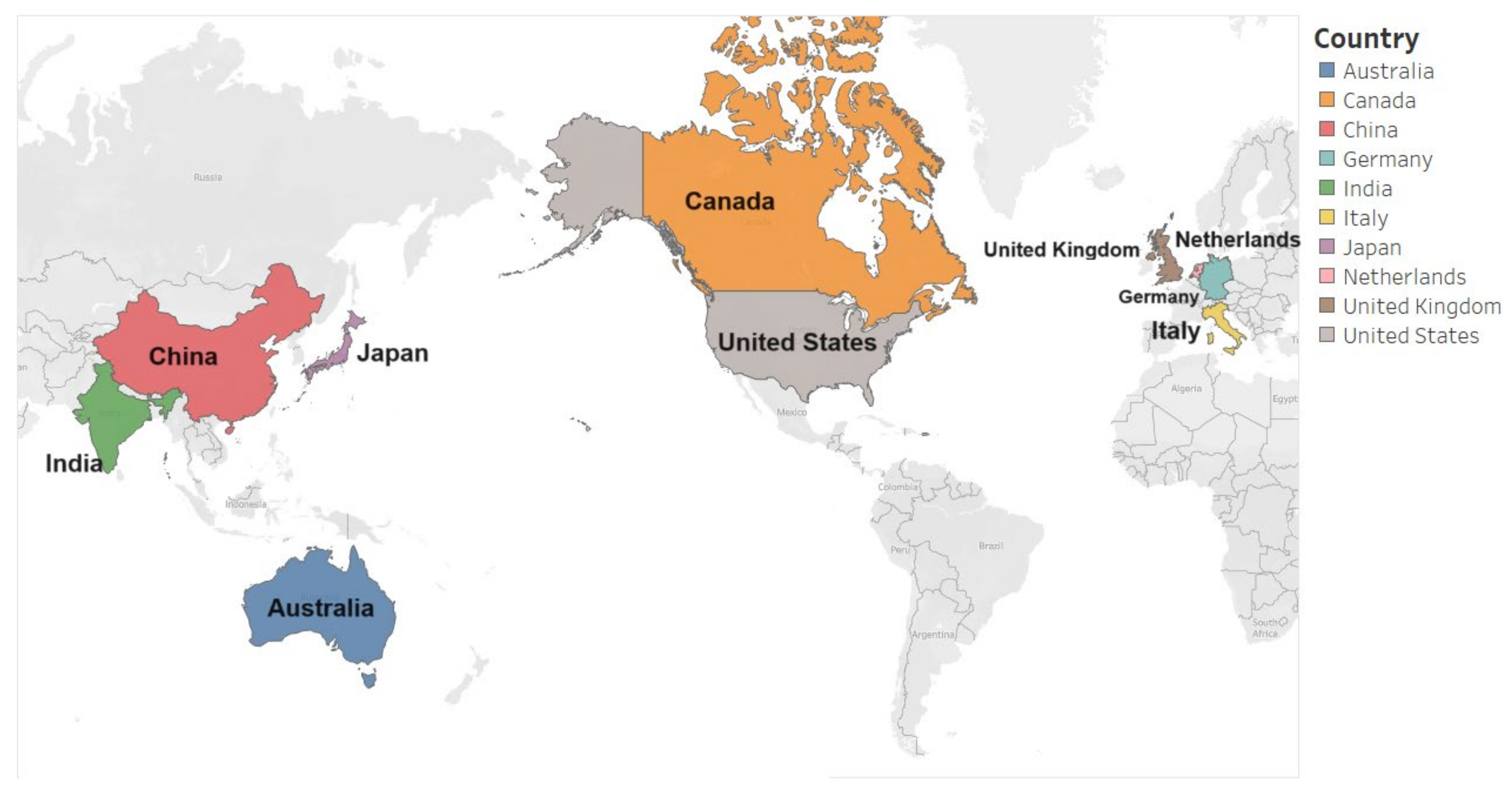
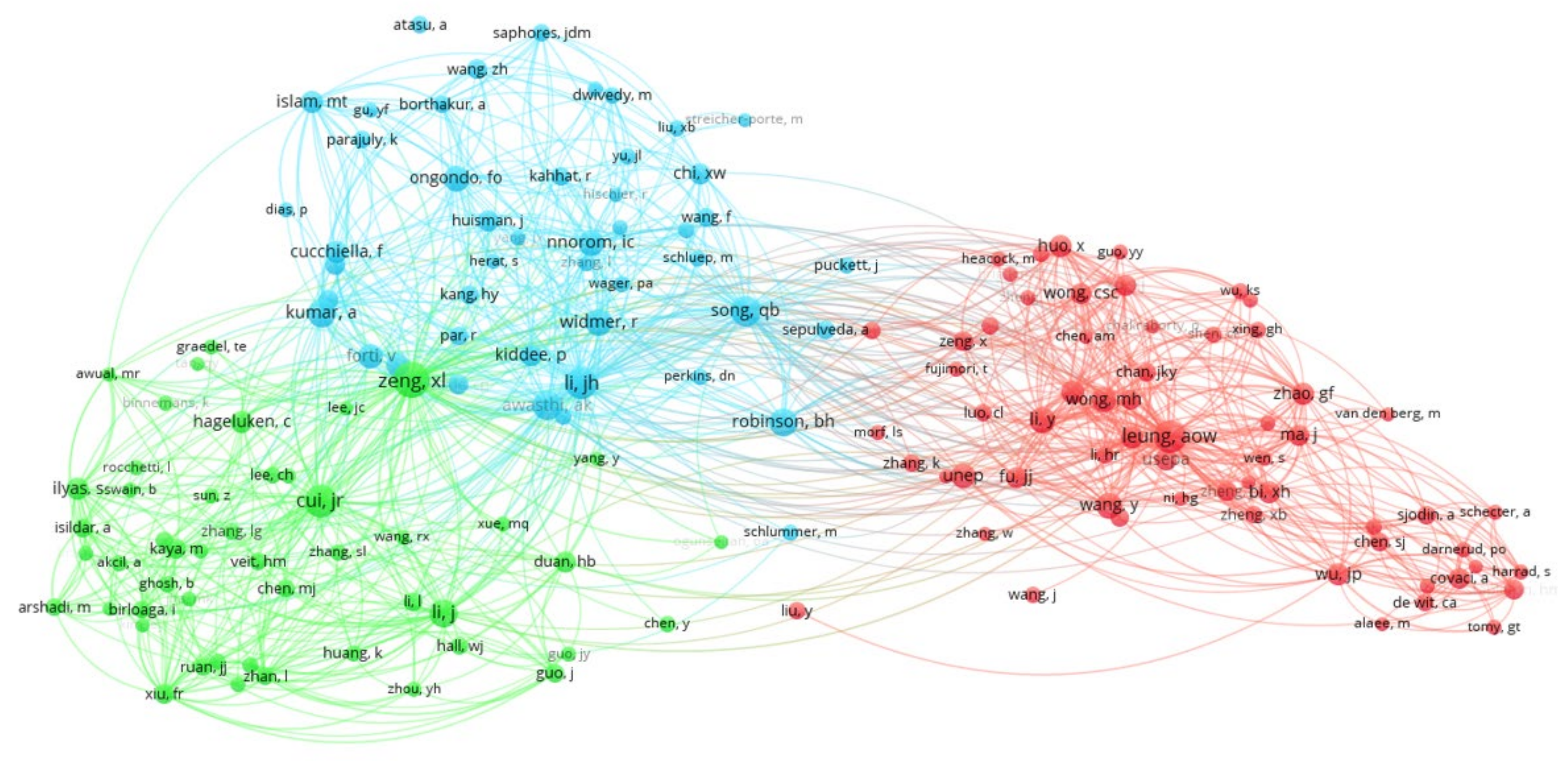
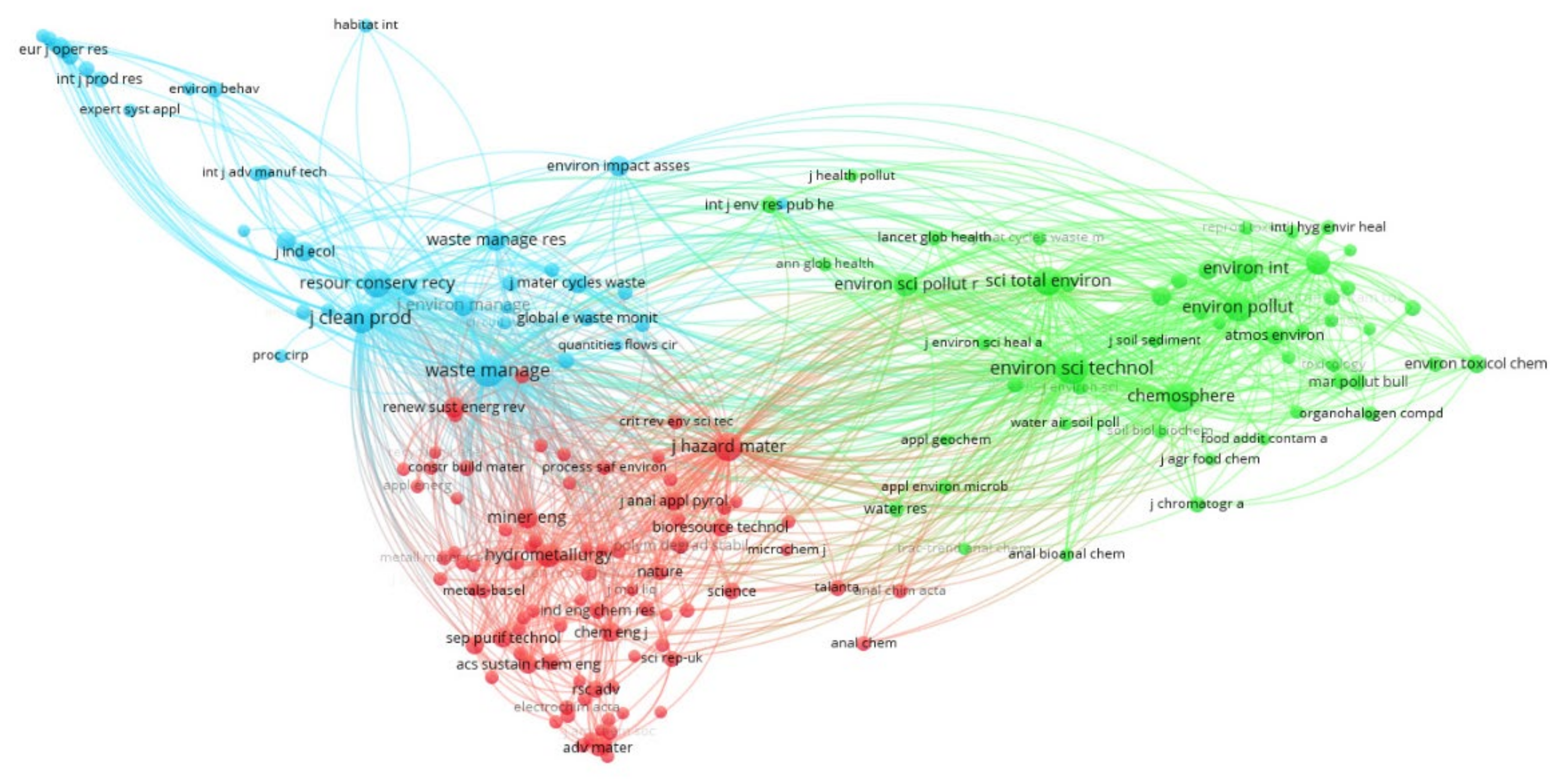


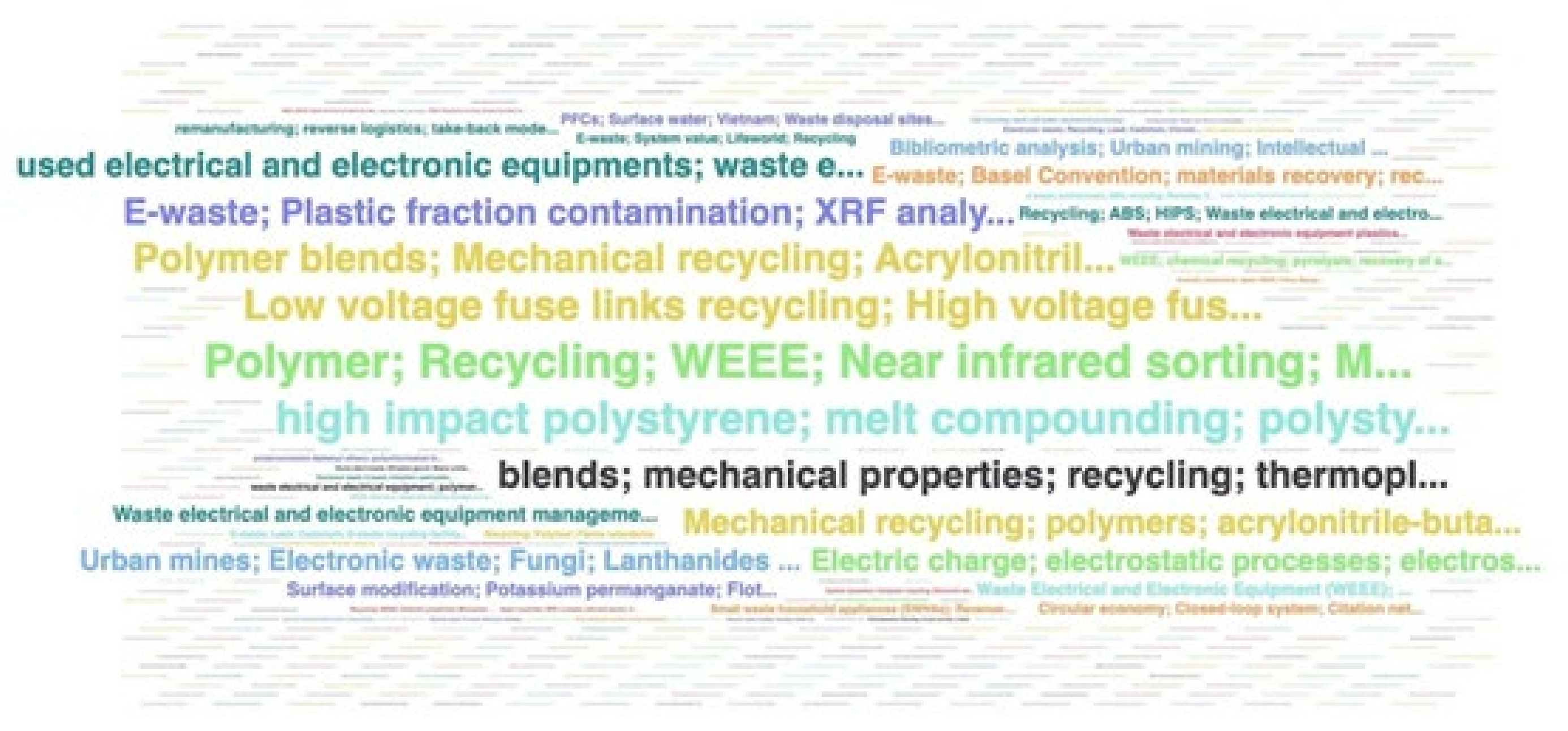
| Languages | Number of Docs | Ratios |
|---|---|---|
| English | 3241 | 99.20% |
| Portuguese | 6 | 0.18% |
| German | 5 | 0.15% |
| Spanish | 5 | 0.15% |
| Chinese | 2 | 0.06% |
| Japanese | 2 | 0.06% |
| Type | Documents |
|---|---|
| Article | 2736 |
| Review | 357 |
| Proceedings paper | 61 |
| Article; early access | 38 |
| Editorial material | 23 |
| Review; abstract | 14 |
| Meeting; abstract | 12 |
| News item | 12 |
| Letter | 5 |
| Correction | 4 |
| Review; book chapter | 4 |
| Retraction | 1 |
| Total | 3267 |
| Country | Region | Documents | Ratios |
|---|---|---|---|
| China | Asia | 1342 | 41.08% |
| United States | Americas | 366 | 11.20% |
| India | Asia | 285 | 8.72% |
| Australia | Australia | 198 | 6.06% |
| United Kingdom | Europe | 149 | 4.56% |
| Japan | Asia | 143 | 4.38% |
| Germany | Europe | 123 | 3.76% |
| Italy | Europe | 119 | 3.64% |
| Canada | Americas | 105 | 3.21% |
| Netherlands | Europe | 82 | 2.51% |
| Journal | Research Areas | Docs | Country | H-Index | IF | SJR |
|---|---|---|---|---|---|---|
| Waste Management | Environmental science | 241 | U.K. | 201 | 8.816 | 1.75 Q1 |
| Journal of Cleaner Production | Business, management, and accounting; energy; engineering; environmental science | 200 | U.K. | 268 | 11.072 | 1.98 Q1 |
| Environmental Science and Pollution Research | Environmental science; pharmacology | 170 | Germany | 154 | 5.19 | 0.94 Q1 |
| Science of the Total Environment | Environmental science | 168 | The Netherlands | 317 | 10.754 | 1.95 Q1 |
| Resources, Conservation, and Recycling | Environmental science; economics, econometrics, and finance | 161 | The Netherlands | 170 | 13.716 | 2.86 Q1 |
| Environmental Pollution | Environmental science; pharmacology; toxicology and pharmaceutics | 117 | U.K. | 275 | 9.988 | 2.11 Q1 |
| Sustainability | Computer science; energy; environmental science; social sciences | 102 | Switzerland | 136 | 3.889 | 0.66 Q1 |
| Environmental Science & Technology | Chemistry; environmental science; pharmacology | 99 | U.S.A. | 456 | 11.357 | 3.12 Q1 |
| Chemosphere | Chemistry; environmental science; pharmacology | 96 | U.K. | 288 | 8.943 | 1.73 Q1 |
| Journal of Hazardous Materials | Environmental science | 80 | The Netherlands | 329 | 14.224 | 2.57 Q1 |
| Author | Affiliation | Country | Citations | TLS | H-Index |
|---|---|---|---|---|---|
| Zheng, X.L. | University of Calgary | Canada | 595 | 10.343 | 50 |
| Leung, A.O.W. | Hong Kong Baptist University | Hong Kong | 488 | 8.557 | N/A |
| Li, J.H. | Tsinghua University | China | 473 | 8.376 | 127 |
| Song, Q.B. | Macau University of Science and Technology | China | 418 | 8.099 | 36 |
| Awasthi, A.K. | Nanjing University Nanjing China | India | 409 | 7.231 | 19 |
| Cui, J.R. | University of Toronto | Canada | 502 | 6.944 | 12 |
| Li, J. | Tsinghua University | China | 364 | 6.282 | 98 |
| Robinson, B.H. | University of Washington | America | 372 | 5.605 | 59 |
| Nnorom, I.C. | Abia State University | Nigeria | 319 | 5.568 | 31 |
| Kumar, A. | IIT (BHU) Varanasi | India | 374 | 5.306 | 152 |
| Journal | Citations | TLS |
|---|---|---|
| Environmental Science & Technology | 10,905 | 480.086 |
| Waste Management | 8779 | 403.737 |
| Chemosphere | 6085 | 354.244 |
| Science of the Total Environment | 5557 | 309.698 |
| Journal of Cleaner Production | 6466 | 296.141 |
| Journal of Hazardous Materials | 5411 | 287.585 |
| Resources, Conservation, and Recycling | 5393 | 243.209 |
| Environmental Pollution | 3985 | 225.700 |
| Environment International | 3816 | 221.645 |
| Hydrometallurgy | 2447 | 142.551 |
| Keywords | Frequency | TLS |
|---|---|---|
| E-waste | 903 | 4.461 |
| Electronic waste | 728 | 3.508 |
| Polybrominated diphenyl ethers | 460 | 2.683 |
| Recycling | 585 | 2.500 |
| Recovery | 505 | 2.422 |
| Brominated flame retardants | 312 | 1.741 |
| Management | 344 | 1.728 |
| WEEE | 355 | 1.681 |
| China | 293 | 1.674 |
| Printed—circuit boards | 290 | 1.635 |
| Cluster | Keywords | Pros | Cons |
|---|---|---|---|
| Cluster 1 (red) | Polybrominated, exposure, children, dibenzo-dioxins, heavy metals, lead, brominated, flame retardants | Exploring the influence of E-waste on human health through a deeper understanding of health impacts can lead to community health awareness. By emphasizing factors related to the impact of E-waste on human health, community awareness of this issue is raised. Furthermore, these discoveries regarding the impact of pollutants can promote health protection measures against the adverse effects of E-waste, further strengthening the link between them. | The challenges related to data completion in research can potentially result in information loss or errors in data collection and analysis. It, in turn, may lead to an inaccurate understanding of health impacts. Additionally, while findings on health impacts can promote protective measures, they may also bring about behavioral change challenges, as changing behaviors and habits may face difficulties and require adjustments. Therefore, the challenges of data completion and potential information loss are interconnected and can influence the effectiveness of promoting health protection measures and behavioral change. |
| Cluster 2 (green) | E-waste, management, WEEE, circular, economy, equipment, sustainability, performance | The increasing adoption of recycling and system improvement strategies in the E-waste industry can not only create competitive opportunities but also drive innovation and creativity. Furthermore, these strategies can help businesses minimize production costs and reduce E-waste by reusing electronic devices. As a result, they make significant contributions to both cost optimization and environmental protection. | The successful implementation of recycling and system improvement strategies within businesses and management can face various challenges, such as difficulties in execution and the need to change the organizational culture. Moreover, consumers play a crucial role in shaping recycling approaches, and their willingness to alter habits may only sometimes be forthcoming. Additionally, while these strategies can potentially reduce production costs, their economic effectiveness may require an initial investment in training and technology updates. |
| Cluster 3 (blue) | Electronic, waste, recycling, recovery, mobile phone, efficiency, classification | Addressing these challenges in implementing recycling and system improvement strategies is essential for promoting sustainable practices. Implementing these strategies within businesses and management may sometimes be complicated and can involve difficulties in execution, along with the need to change the organizational culture. Moreover, achieving success in changing the approach to recycling often requires active engagement and interaction from consumers, who may only sometimes be willing to alter their habits. Furthermore, while these strategies have the potential to reduce production costs, they may also necessitate an initial investment in training and technology updates, making economic effectiveness a critical consideration in their adoption. | Overcoming the technological and process challenges associated with recovering and recycling materials from used electronic devices is a crucial step in promoting sustainability. These challenges may entail the development and implementation of complex technologies and processes, making it essential to invest in research and innovation. Ensuring the quality of materials recovered from used electronic devices is another challenge that needs to be addressed to guarantee the safety and effectiveness of recycling and reuse processes. Additionally, promoting recycling and material recovery from old electronic devices involves changing consumer and business habits and raising awareness about the importance of these practices for a sustainable future. These interconnected challenges necessitate collaborative efforts and innovative solutions to drive positive change in the E-waste recycling landscape. |
Disclaimer/Publisher’s Note: The statements, opinions and data contained in all publications are solely those of the individual author(s) and contributor(s) and not of MDPI and/or the editor(s). MDPI and/or the editor(s) disclaim responsibility for any injury to people or property resulting from any ideas, methods, instructions or products referred to in the content. |
© 2023 by the authors. Licensee MDPI, Basel, Switzerland. This article is an open access article distributed under the terms and conditions of the Creative Commons Attribution (CC BY) license (https://creativecommons.org/licenses/by/4.0/).
Share and Cite
Le, M.-H.; Lu, W.-M.; Chang, J.-C. Recycling E-Waste and the Sustainable Economy: A Bibliometric Exploration. Sustainability 2023, 15, 16108. https://doi.org/10.3390/su152216108
Le M-H, Lu W-M, Chang J-C. Recycling E-Waste and the Sustainable Economy: A Bibliometric Exploration. Sustainability. 2023; 15(22):16108. https://doi.org/10.3390/su152216108
Chicago/Turabian StyleLe, Minh-Hieu, Wen-Min Lu, and Jui-Chen Chang. 2023. "Recycling E-Waste and the Sustainable Economy: A Bibliometric Exploration" Sustainability 15, no. 22: 16108. https://doi.org/10.3390/su152216108
APA StyleLe, M.-H., Lu, W.-M., & Chang, J.-C. (2023). Recycling E-Waste and the Sustainable Economy: A Bibliometric Exploration. Sustainability, 15(22), 16108. https://doi.org/10.3390/su152216108







